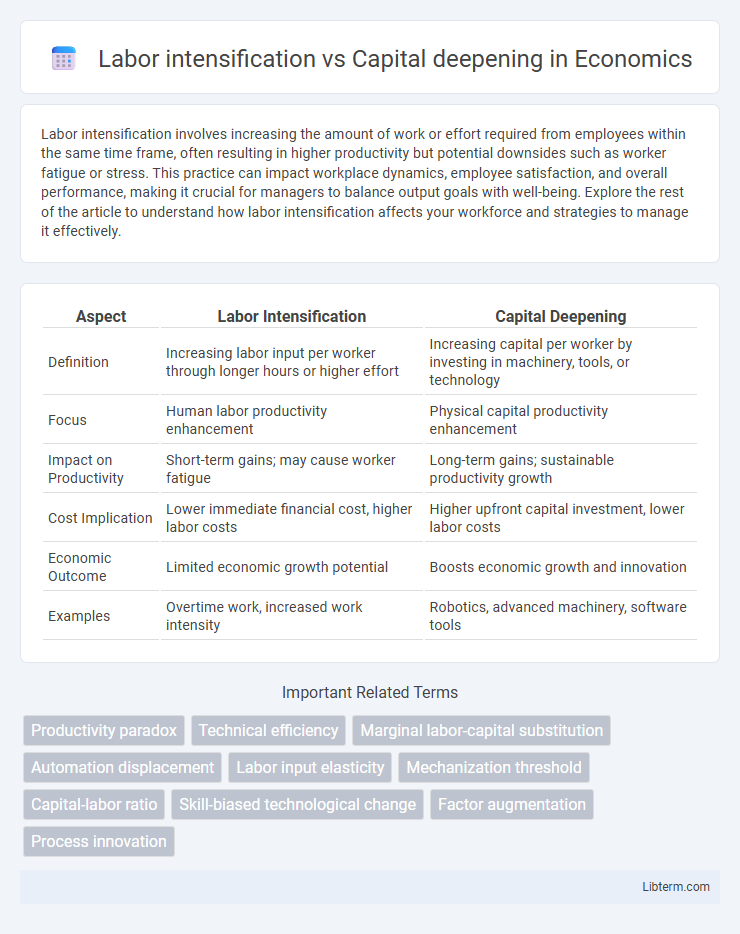Labor intensification involves increasing the amount of work or effort required from employees within the same time frame, often resulting in higher productivity but potential downsides such as worker fatigue or stress. This practice can impact workplace dynamics, employee satisfaction, and overall performance, making it crucial for managers to balance output goals with well-being. Explore the rest of the article to understand how labor intensification affects your workforce and strategies to manage it effectively.
Table of Comparison
| Aspect | Labor Intensification | Capital Deepening |
|---|---|---|
| Definition | Increasing labor input per worker through longer hours or higher effort | Increasing capital per worker by investing in machinery, tools, or technology |
| Focus | Human labor productivity enhancement | Physical capital productivity enhancement |
| Impact on Productivity | Short-term gains; may cause worker fatigue | Long-term gains; sustainable productivity growth |
| Cost Implication | Lower immediate financial cost, higher labor costs | Higher upfront capital investment, lower labor costs |
| Economic Outcome | Limited economic growth potential | Boosts economic growth and innovation |
| Examples | Overtime work, increased work intensity | Robotics, advanced machinery, software tools |
Introduction to Labor Intensification and Capital Deepening
Labor intensification involves increasing the amount of labor input per unit of output, often resulting in longer working hours or intensified worker effort without significant technological changes. Capital deepening refers to increasing the amount of capital per worker, enhancing productivity through investments in machinery, equipment, and technology. Both strategies aim to boost economic growth but differ in reliance on human labor versus technological advancement for efficiency gains.
Defining Labor Intensification
Labor intensification refers to increasing the amount of work performed by employees within a given time period without increasing the number of workers, often through higher productivity demands or extended working hours. This approach contrasts with capital deepening, which involves boosting productivity by investing in more or better machinery or technology. Understanding labor intensification is crucial for analyzing workforce dynamics and its impact on employee well-being and output efficiency.
Understanding Capital Deepening
Capital deepening refers to the increase in the amount of capital per worker, enhancing productivity by equipping employees with more or better tools, machinery, and technology. This process drives economic growth by enabling higher output without a proportional increase in labor input, fostering innovation and efficiency. Understanding capital deepening highlights its role in improving labor quality and encouraging sustainable development through technology investments and infrastructure upgrades.
Key Differences between Labor Intensification and Capital Deepening
Labor intensification increases output by boosting the amount of work per unit of labor without significantly changing technology, relying heavily on human effort and extended working hours. Capital deepening involves increasing capital investment relative to labor, enhancing productivity through advanced machinery, tools, and technology adoption. The key difference lies in labor intensification emphasizing more labor input, while capital deepening focuses on improving labor efficiency via better capital resources.
Economic Impacts of Labor Intensification
Labor intensification increases output by requiring workers to perform more tasks or work faster without additional capital investment, often leading to higher short-term productivity but risks worker fatigue and reduced long-term efficiency. Economies relying on labor intensification may experience increased employment but face challenges such as wage stagnation and diminished worker well-being. This approach contrasts with capital deepening, where investments in technology and machinery typically drive sustainable productivity growth and higher wages.
Productivity Effects of Capital Deepening
Capital deepening, defined as an increase in the capital-to-labor ratio, directly enhances productivity by providing workers with more advanced machinery, tools, and technology, enabling higher output per labor hour. It leads to technological progress and skill acquisition that amplify the efficiency of labor, unlike labor intensification which mainly increases work input without improving overall efficiency. Empirical studies show that economies experiencing sustained capital deepening enjoy higher total factor productivity growth and increased standards of living compared to those relying solely on labor intensification.
Pros and Cons of Labor Intensification
Labor intensification enhances workforce productivity by increasing employee effort or hours, leading to higher output without significant new capital investment. Pros include improved flexibility, quicker adaptation to market changes, and lower upfront costs compared to capital deepening. Cons involve risks of worker burnout, decreased job satisfaction, and potential declines in long-term productivity due to overexertion and fatigue.
Advantages and Disadvantages of Capital Deepening
Capital deepening enhances productivity by increasing the amount of capital per worker, leading to improved technology use and higher output efficiency. It requires significant investment costs and can result in diminishing returns if not matched with skilled labor or appropriate infrastructure. While it fosters economic growth and innovation, capital deepening may also cause structural unemployment due to automation and reduced demand for manual labor.
Case Studies: Industry Examples
Labor intensification involves increasing output by adding more human effort, as seen in garment manufacturing in Bangladesh where workers extend shifts to boost production without new machinery. Capital deepening means investing in advanced technology and equipment to raise productivity per worker, exemplified by the automotive industry in Germany using robotics and automation to streamline assembly lines. Case studies highlight how labor-intensive methods dominate in low-cost economies, whereas capital deepening prevails in high-tech industrialized nations aiming for efficiency and product quality.
Future Trends in Labor and Capital Investment Strategies
Labor intensification involves maximizing output by increasing worker efficiency and hours, while capital deepening emphasizes investing in advanced machinery and technology to enhance productivity per worker. Future trends show a shift toward hybrid strategies where firms leverage artificial intelligence and automation for capital deepening, balanced by upskilling labor to optimize human-machine collaboration. Investment strategies prioritize digital infrastructure, robotics, and continuous workforce training to sustain competitive advantage in evolving economic landscapes.
Labor intensification Infographic

 libterm.com
libterm.com